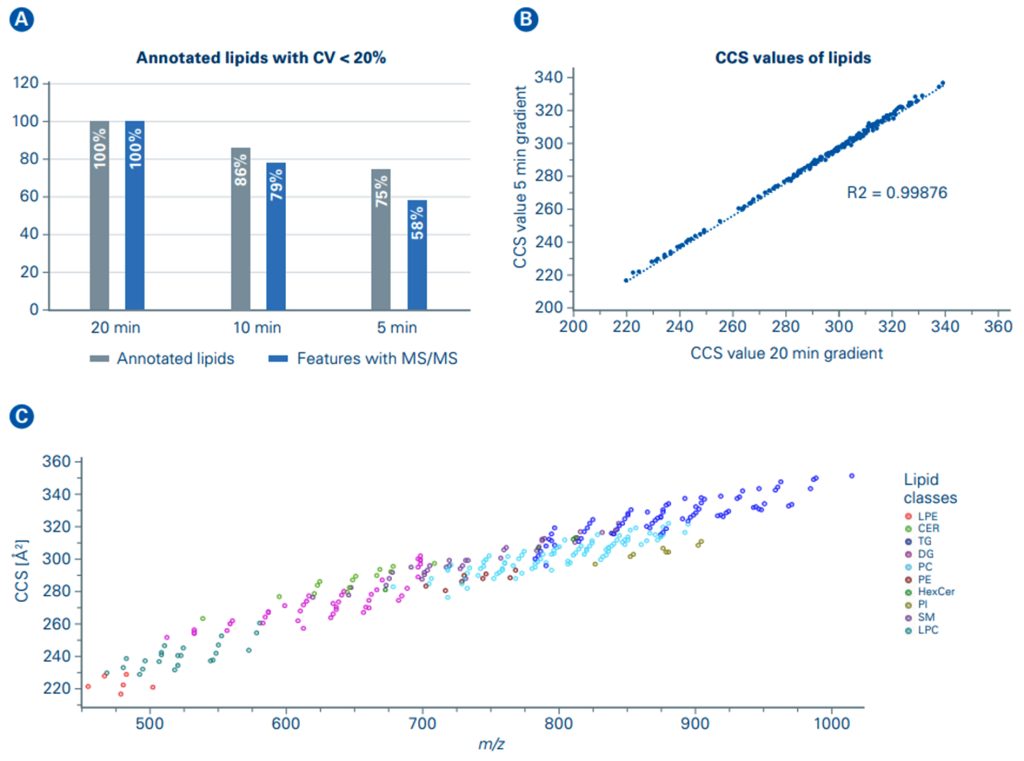By Lucy Woods, PhD
We know very well that metabolites—small molecules such as lipids, sugars, nucleotides, and amino acids—play a large role in cellular biochemistry. But we are only beginning to understand the many ways metabolites are involved in health and disease. Only recently have metabolites been subjected to comprehensive profiling, that is, to metabolomics research. With its powers enhanced by new technology, metabolomics research is enriching our understanding of disease pathogenesis and enabling the discovery of diagnostic biomarkers.
It should be noted that metabolomics and emerging subdisciplines such as lipidomics are recapitulating the development of other omics disciplines such as genomics and proteomics. Signs of progress include powerful applications in translational and clinical research. Ultimately, metabolomics and lipidomics will contribute to the realization of precision medicine.

A common approach in metabolomics research is untargeted or “global” metabolite profiling. It is being used to uncover links between cellular pathways and biological processes. Such discoveries can reshape our understanding of cell biology, physiology, and medicine. However, metabolic pathways involve isomer metabolites—metabolites that have structural variations. The presence of isomer metabolites makes reliable compound identification and accurate interpretation of data very difficult.
Mass spectrometry (MS) is a mainstay in metabolomics, due to its ability to quantitatively measure thousands of metabolites from small amounts of biological material. But even high-performance MS instruments struggle to analyze separate isomers due to the chemical similarity of isomer metabolites. Because isomers can have the same mass, charge, and physical properties, separation and identification are time- and resource-intensive processes.
In addition, the metabolome is extremely sensitive; a person’s metabolic phenotype is influenced by environmental factors and holds enormous variation. Data can also be more ambiguous because metabolites are the products of upstream biological transformations of molecules in a similar mass range, which requires higher sensitivity to obtain broad metabolite coverage and relative concentrations.
Overcoming the isomer challenge
Ion mobility spectrometry (IMS) has long been used for the post-ionization separation and structural characterization of biomolecules, and its combination with MS has provided researchers with the tools to separate molecules in a third dimension, using collisional cross section (CCS) values. IMS-MS not only allows the measurement of ion size and separation of isomers with the same mass-to-charge (m/z) ratio, but it also increases dynamic range and peak capacity compared with MS alone. It has therefore emerged as a powerful technology to address the isomer metabolite challenge, and the use of IMS-MS in untargeted metabolomics now supports metabolite identification through the generation of orthogonal data (CCS values).
New technology is continually being developed to achieve a deeper understanding of the biological relevance of metabolites in health and disease. Since its commercialization in 2016, trapped ion mobility spectrometry (TIMS)-MS has contributed to significant advances in biomolecule separation and characterization. Its higher mobility resolving power enables the separation of molecules with differences in their CCS values so small that traditional IMS-MS cannot distinguish them. In addition, the novel scan mode termed parallel accumulation–serial fragmentation (PASEF) multiplies the sequencing speed without any loss in sensitivity.1
TIMS in lipidomics
The acceleration of metabolomics research has driven new developments in lipid biochemistry. Lipids are fatty small molecules that share common physical and chemical properties, and the abundance of lipids and different lipid classes is key to metabolic regulation. As metabolomic possibilities progress, lipidomics becomes a prominent source of collecting and measuring data within the metabolome. Because the high isomeric content of lipids and the varying abundance of lipids in typical samples such as plasma extracts, analytical equipment with high sensitivity and dynamic range is required.
In a recent study, a workflow was introduced to simplify the annotation and validation process of lipid isomers.2 This workflow is called 4D-Lipidomics™, and it leverages PASEF-powered TIMS. The study described how the lipid content of a NIST SRM 1950 extract from reference plasma (Sigma-Aldrich, Germany) was profiled using the 4D-Lipidomics workflow, which incorporated reversed-phase liquid chromatography (RP-LC) (Elute UHPLC system, Bruker, Germany); TIMS-MS and MS/MS data acquisition in PASEF MS/MS mode (timsTOF Pro, Bruker, Germany); and the processing of four-dimensional data (m/z, mobility, and intensity) with MetaboScape 2021b software (Bruker, Germany).
To investigate the increased MS/MS quality and peak capacity provided by PASEF, the SRM 1950 lipid extract was analyzed with different chromatographic run times (20, 10, and 5 minutes).
The maximum number of unique identified lipids (362) was observed with 20-min gradient times, and even when the runtime was reduced to 5 mins, 75% (271) of the annotated lipids with a CV of less than 20% were still detected (Figure 1A). A comparison of the measured CCS values from the 20-min and 5-min gradients shows a very good correlation (Figure 1B), which demonstrates that, in contrast with retention times, CCS values are independent of liquid chromatography and can be reliably used for compound identification (Figure 1C).

The results highlight the high MS/MS coverage that can be achieved using PASEF and how automatically acquired CCS values increase confidence in annotations and compound identification. These results set the stage for deep lipidomics profiling. Methods such as 4D-Lipidomics can achieve high throughput to enable studies that require a high turnover. Such studies include clinical research studies.
Looking toward the future of personalized medicine
Molecular alterations at the metabolome level reflect disturbances in preceding biological cascades, bridging the gap between the genome and phenotype. Changes at this level can lead to the onset of disease symptoms, making metabolomics an essential diagnostic and prognostic tool in investigating the mode of action of chemical compounds and obtaining an in-depth understanding of the impact of infection, for example.3
Current metabolomics research focuses on a range of challenging diseases, including Alzheimer’s disease and cancer, and scientists are looking further into metabolomics to examine how the cells in our body behave and what this could mean as we look toward a future of personalized medicine.
As new technologies evolve and researchers look to optimize equipment to accelerate their studies, it is important that software and analytics keep pace to support the abundance of new data. Advances in MS technology such as TIMS bring researchers a step closer to a future in which personalized medicine is perceived to be within reach. For more information
Lucy Woods, PhD, is the global business unit manager for metabolomics and lipidomics at Bruker Daltonics.
References
1. Meier F, Brunner A-D, Kock S, et al. Online Parallel Accumulation—Serial Fragmentation (PASEF) with a Novel Trapped Ion Mobility Mass Spectrometer. Mol. Cell. Proteomics 2018; 17(12): 2534–2545.
2. Zubeil F, Heyman HM, Korf A, et al. 4D-Lipidomics™ workflow for increased throughput. Bruker Daltonics. Application Note LCMS-179, 2021.
3. Tounta V, Liu Y, Cheyne A, Larrouy-Maumus, G. Metabolomics in infectious diseases and drug discovery. Mol. Omics 2021; 17(3): 376–393.





Comments are closed.